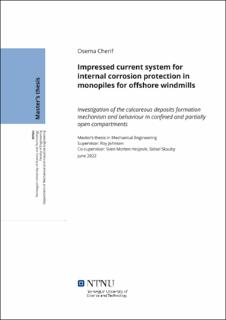| dc.description.abstract | Impressed current cathodic protection (ICCP) is a highly effective corrosion protection system for submerged structures. When polarising the steel to its immune state by applying a protective current, the interfacial pH increases as a result leading to the precipitation of calcareous deposit on the steel surface. The calcareous deposits acts then as a protective coating as it is a good barrier against oxygen diffusion on the steel surface. Thus, lowering the current demand. However, when it comes to confined spaces, the application of ICCP leads to the production of chlorine which decreases the pH as there is no water renewal.
The reduction of pH creates then new challenges as the interfacial pH is decreased and the precipitation of the calcareous deposit is hindered. The calcareous deposits depends on various factors such as the applied potential, current density, pH, seawater chemistry, flow rate etc. The following factors
have been investigated through literature to build an understanding of how they may affect the calcareous deposits such that they can be adjusted to build an effective calcareous deposit layer for a sustainable cathodic protection system. Hence, a literature review combined with testing were conducted to answer the following problem.
During this MSc project, three ICCP systems were simulated. The first two systems were ICCP system in simulated confined environment of grinded and precorroded samples. The third and last ICCP system was conducted on both precorroded and grinded samples in a simulated partially open environment with a weekly water exchange of 10\% every 1-2 weeks. The steel samples were polarised to -1050 mV vs. Ag|AgCl for 12 weeks at room temperature. The current density after 12 weeks of continuous polarisation of the precorroded and grinded samples was measured to be 170 $\frac{mA}{m^2}$ and 190 $\frac{mA}{m^2}$, respectively. Meanwhile, the final current density in the water renewal system was found to be 290 $\frac{mA}{m^2}$.
Furthermore, the quality of the calcareous deposit was investigated through SEM and EDS analyses. It was found that the precorroded samples had a calcareous deposit made of magnesium hydroxide and large amounts of calcium carbonate. Meanwhile, the grinded samples was made of primarily magnesium hydroxide with some calcium carbonate. Hence, the precorroded samples had a better calcareous deposit quality. The suppression of the formation of the calcium carbonate on the grinded samples was hindered by the low pH, as the duration of the acidification lasted twice as long for these samples compared to the precorroded samples. Hence, the magnesium hydroxide is the favorable mineral under low pH and the calcium carbonate is the favorable mineral at more neutral pH.
The acidification behaviour observed in the three experiment varied but ultimately followed the same trend. Acidification was observed in all three experiments, however, the duration of acidification seemed to increase with the increase of the volume to area ratio. Hence, a hypothesis was proposed to explain the behaviour of the pH with respect to the measured current density and the counter electrode potential. It was hypothesised that the initial cause of acidification was indeed the CER. However, this mechanism changed as the cause of acidification was believed to be induced by the formation of magnesium hydroxide. And that the neutralisation of pH is a result to the stoppage of the formation of this mineral. The following hypothesis was supported by investigating the CER potential limit which was measured to lay between approximately 1160-1200 mV vs. Ag|AgCl.
After approximately 6 weeks of continuous polarisation, one grinded and one precorroded samples were disconnected from the CP system to freely corrode for 1 week. Thereafter, they were connected back to the system to measure the repolarisation current density. This was done under neutral pH. Similar experiment was done but at low pH. A precorroded sample was continuously polarised for 1 week before disconnecting it from the CP system to freely corrode for 6 days before repolarising the sample. The repolarisation current density exhibited a similar behavior to the one observed under neutral pH. And the main difference in the repolarisation under low and neutral pH was the duration before the curve converged back to the curve of the continuously polarised samples. | |
